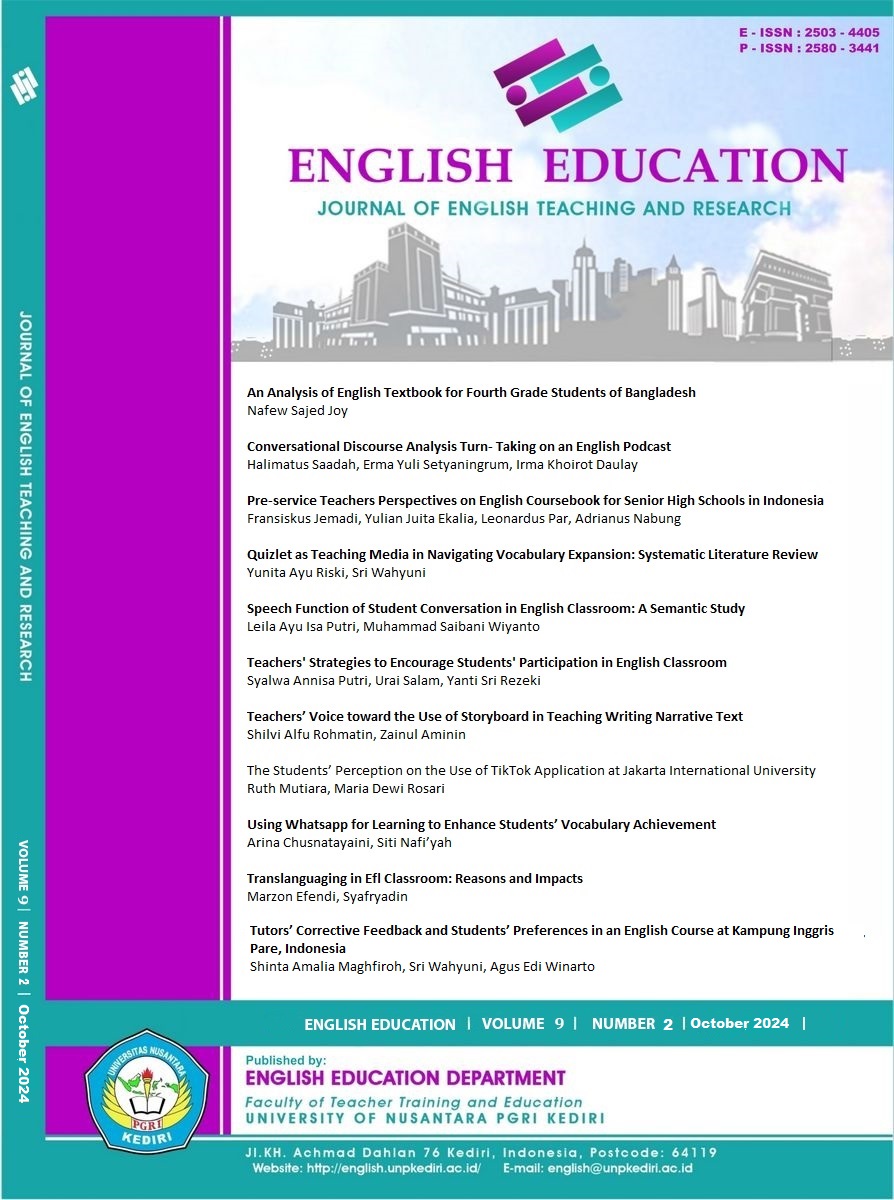The Students’ Perception on the Use of TikTok Application at Jakarta International University
DOI:
https://doi.org/10.29407/jetar.v9i2.22781Keywords:
English pronunciation; perception; pronunciation challenge; TikTok, TikTok, pronunciation challenge, English pronunciation, perceptionAbstract
Nowadays, social media like TikTok is utilized for various purposes. It is used for entertainment and educational purposes. That is why, many English learners used TikTok to learn English, specifically English pronunciation. This study aims to find the students’ perception of learning English pronunciation through the TikTok application. In order to find the students’ perception, the researchers used qualitative method by involving 16 first-year students majoring in English literature.Then a questionnaire consisting of 13 open-ended questions was used to collect the data. The findings indicated that most participants showed positive perceptions as they enjoyed learning English pronunciation through TikTok since it was fun, stress-relieving, and convenient. Moreover, they experienced an improvement in their pronunciation skill and thus, most of them agree that TikTok can be an effective learning method to learn English pronunciation.
Downloads
References
Andini, P., & Zaitun. (2023). “The Effectiveness of Learning Pronunciation Through English Content by English With Lucy on YouTube.” Jurnal Studi Guru Dan Pembelajaran 5(2):201–6. doi: 10.30605/jsgp.5.2.2022.1542.
Creswell, J., W. (2014). Research design: qualitative, quantitative, and mix methods (4th ed.) SAGE Publications, Inc.
Dahliana, Supriatin, A., & Septiana, N. (2020). “LITERATURE STUDY: THE IMPACT OF THE USE OF TIKTOK APPLICATION ON EDUCATION IN INDONESIA.” Proceeding of ICONIE FTIK IAIN Pekalongan Eco-Pesantren: 1189–1200.
Dewi, L., K., & Arifani, Y. (2021). “The Utilization of Line Video Call and Tiktok Video for Teaching Pronunciation in Thailand.” Celtic: A Journal of Culture 8(2):260–74. doi: 10.22219/celtic.v8i2.18481.
Hasanah, M., & Wahono. S., S. (2022). “Watching English Native Speakers ’ Youtube Channel to Improve Students ’ Pronunciation Ability.” Journal of Language Intelligence and Culture 4(1):15–32. doi: 10.35719/jlic.v4i1.77.
Isadaud, D., M., Fikri, M., D., & Bukhari, M., I., (2022). “The Urgency Of English In The Curriculum In Indonesia To Prepare Human Resources For Global Competitiveness.” DIAJAR: Jurnal Pendidikan Dan Pembelajaran 1(1):51–58. doi: 10.54259/diajar.v1i1.177.
Johns, G., & Saks, A., M. (2019). Organizational behaviour: understanding and managing life at work (11th ed.). Pearson Canada.
Komariyah, T., Sulistiowati, W., Fajri, A., L., & Allatif, N. (2022). “The Implementation of TikTok Application to Learn Speaking Skill in English Language Teaching (ELT).” Conference on English Language Teaching 2(Celti):142–54. doi: 10.24090/celti.v2.43.
Kumar, R. (2011). Research methodology: a step-by-step guide for beginners. (3rd ed.). SAGE Publications, Inc.
Miles, M., B., Huberman, A., M., & Saldaña, J., (2014). Qualitative data analysis: a methods sourcebook (3rd ed.). SAGE Publications, Inc.
Novitasari, & Addinna, A. (2022). “Students’ Perception on the Use of TikTok for Learning English.” Journal of English Language Teaching 11(4):566–79. doi: 10.24036/jelt.v11i4.119484.
Pertami, D., Chotimah, C., & Astiyanda, T. (2023). “THE USE OF THE FLOANDDAY TIKTOK CHANNEL IN PRONUNCIATION.” Lingua 19(1):93–100. doi: 10.34005/lingua.v19i1.2665.
Pratiwi, A., E., Ufairah, N., N., & Sopiah, R., S. (2021). “UTILIZING TIKTOK APPLICATION AS MEDIA FOR LEARNING ENGLISH PRONUNCIATION.” International Conference on Education of Suryakancana (IConnects Proceedings) 11(1):372–82. doi: https://doi.org/10.35194/cp.v0i0.1374.
Putri, S., M., D. (2022). “The Effectiveness of Using Tiktok To Improve Efl Learners’ Speaking Ability.” Mimesis 3(2):101–10. doi: 10.12928/mms.v3i2.6096.
Qiong, O. (2017). “A Brief Introduction to Perception.” Studies in Literature and Language 15(4):18–28. doi: 10.3968/10055.
Rachmawati, R., & Cahyani, F. (2020). “The Use of Youtube Videos in Improving Non-English Department Students’ Pronunciation Skills.” Alsuna: Journal of Arabic and English Language 3(2):83–95. doi: 10.31538/alsuna.v3i2.916.
Rosari, M., D., & Ena, O., T. (2019). “Inaccurate Pronunciations of English Vowel Sounds By Online Indonesian English Teachers.” Academic Journal Perspective : Education, Language, and Literature 7(2):65. doi: 10.33603/perspective.v7i2.2557.
Saldaña, J. (2016). The coding manual for qualitative researchers (3rd ed.). SAGE Publications, Inc.
Talib, H., Anwar, & Mujahidah. (2018). “IMPLEMENTING LISTEN AND IMITATE TECHNIQUE Inspiring : English Education Journal.” 1(1):1–12.
Yagi, J., I., & Rosari, M., D. (2023). “English Consonant Mispronunciation By Jakarta International University's Final Year Students.” 5(1).
Yang, H. (2020). “Secondary-School Students’ Perspectives of Utilizing Tik Tok for English Learning in and beyond the EFL Classroom.” International Conference on Education Technology and Social Science (Etss):162–83.
Downloads
Published
Issue
Section
License
Authors who publish with this journal agree to the following terms:
- Copyright on any article is retained by the author(s).
- The author grants the journal, the right of first publication with the work simultaneously licensed under a Creative Commons Attribution License that allows others to share the work with an acknowledgment of the work’s authorship and initial publication in this journal.
- Authors are able to enter into separate, additional contractual arrangements for the non-exclusive distribution of the journal’s published version of the work (e.g., post it to an institutional repository or publish it in a book), with an acknowledgment of its initial publication in this journal.
- Authors are permitted and encouraged to post their work online (e.g., in institutional repositories or on their website) prior to and during the submission process, as it can lead to productive exchanges, as well as earlier and greater citation of published work.
- The article and any associated published material is distributed under the Creative Commons Attribution-ShareAlike 4.0 International License








 Article template
Article template



